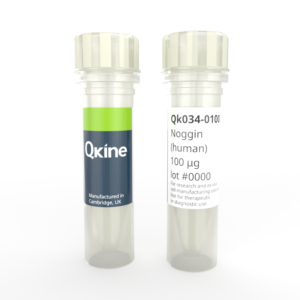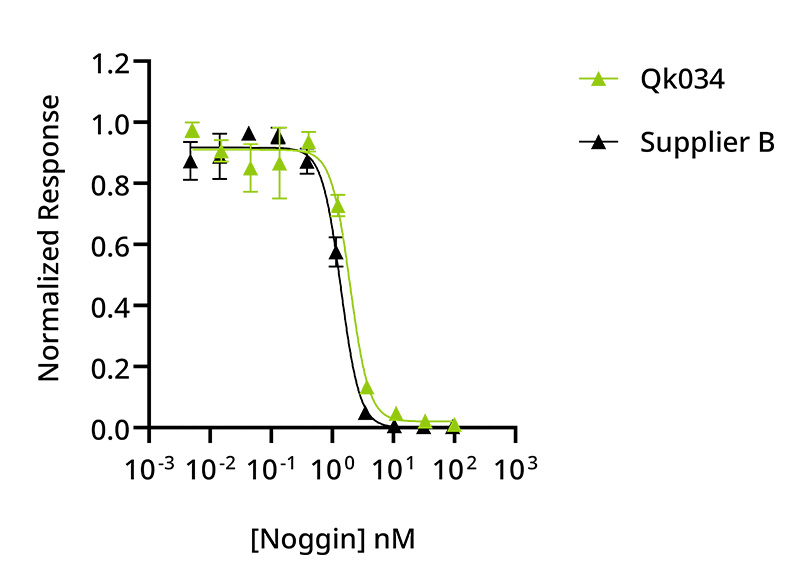 Recombinant human noggin protein (Qk034)
Recombinant human noggin protein (Qk034)Recombinant human noggin protein (Qk034)
Price range: £230.00 through £2,900.00
Human noggin is a bone morphogenetic protein (BMP) antagonist which regulates cell differentiation and growth. Noggin is used in the culture of intestinal, pancreatic, lung and tumor-derived organoids and the maintenance of undifferentiated embryonic stem cells (ESC) and for stem cell differentiation into neural and microglial lineages.
Qkine human noggin (Qk034) is a highly pure, animal origin-free, bioactive 46 kDa dimer for reproducible results in organoid culture.
In stock
Orders are typically shipped same or next day (except Friday).
Easy world-wide ordering, direct or through our distributors.
Price range: £230.00 through £2,900.00
Buy online with secure credit card or purchase order. For any questions, please email orders@qkine.com
Summary:
- High purity human noggin protein (Uniprot: Q13253)
- 46 kDa (dimer)
>98%, by SDS-PAGE quantitative densitometry
Expressed in E. coli
Animal origin-free (AOF) and carrier protein-free
Manufactured in our Cambridge, UK laboratories
Lyophilized from acetonitrile, TFA
- Resuspend in 10 mM HCl (Reconstitution solution A) at >50 µg/ml, add carrier protein if desired, prepare single-use aliquots and store frozen at -20 °C (short-term) or -80 °C (long-term)
Featured applications:
Tumor organoid culture
Epithelial organoid culture
Stem cell differentiation into neural and microglial lineages
- Recombinant human FGF-10 protein (Qk003)
- Recombinant human R-spondin 1 protein (Qk006)
- Recombinant human R-spondin 3 protein (Qk032)
- Recombinant human BMP-2 protein (Qk007)
- Recombinant human EGF protein (Qk011)
- Recombinant human KGF (FGF-7) protein (Qk046)
- Recombinant human DKK-1 protein (Qk068)
- Recombinant human FGF-1 protein (Qk071)
- Recombinant human Shh protein (Qk055)
- Recombinant human FGF-4 protein (Qk004)

Human noggin is a BMP inhibitor, and its activity is determined by inhibition of BMP-2 (Qk007) activity in a BMP-2 responsive firefly luciferase reporter assay. HEK293T cells were treated in triplicate with a serial dilution of noggin and a standard concentration of BMP-2 for 6 hours. Firefly luciferase activity was measured and normalized to the control Renilla luciferase activity. EC50 = 1.5 nM (70.1 ng/ml). Data from Qk034 lot #104291.
Noggin protein (Qk034) has an unusual migration in non-reduced (NR) SDS-PAGE due to the non-covalent dimer which is the active protein. Similar migration in SDS-PAGE is seen for gremlin-1, a related BMP antagonist. The identity of the purified dimeric protein was confirmed using mass spectrometry. Upon reduction, the protein monomer migrates at 23 kDa. Purified recombinant human noggin protein (7 μg) was resolved using 15% w/v SDS-PAGE in reduced (+β-mercaptoethanol, R) and non-reduced conditions (NR) and stained with Coomassie Brilliant Blue R250. Data from Qk034 lot #104285.

Further quality assays
Mass spectrometry: single species with expected mass
Recovery from stock vial: >95%
Endotoxin: <0.005 EU/μg protein (below level of detection)
We are a company founded and run by scientists to provide a service and support innovation in stem cell biology and regenerative medicine. All our products are exceptionally high purity, with complete characterisation and bioactivity analysis on every lot.

Qkine human noggin is as biologically active as a comparable alternative supplier protein. Quantitative luciferase assay with Qkine human noggin (Qk034, green) and alternative supplier noggin (Supplier B, black) inhibition of BMP-2 (Qk007). Cells were treated in triplicate with a serial dilution of noggin and a standard concentration of BMP-2 for 6 hours. Firefly luciferase activity was measured and normalized to control Renilla luciferase activity.
Technote | Noggin (Qk034) bioactivityProtein background
Noggin is a 64 kDa homodimeric glycoprotein expressed during embryonic development and in adult cells [1]. Noggin is an extracellular antagonist of BMP cell signaling. BMPs are part of the larger TGFβ family and regulate embryonic, fetal and adult development in all vertebrates [1, 2]. Noggin binds to BMP-2, -4, -6 and -7, preventing interaction of the ligands with their receptor, and consequently blocking downstream activation of signaling cascades [2,3].
Through its control of BMP signaling, noggin plays a crucial role in embryonic patterning, as well as in the development of the neural tube, teeth, hair follicles, and the eye [4]. In cell cultures, noggin is used in the maintenance of pluripotent stem cells, differentiation of iPSCs to neural lineages, and in a large variety of organoid culture systems including intestine, liver and lung organoids [4, 5].
Additional resources
- Technote | Noggin (Qk034) bioactivity
- Differentiation of induced pluripotent stem cells (iPSCs) into neuroectoderm (PDF)
- Poster: Neural and glial cell maintenance and differentiation
- Poster: Pluripotent stem-cell derived organoids
- Poster: Adult stem-cell derived organoids
- Brochure: Growth factors for neural and glial cell differentiation
- Brochure: Growth factors for enhanced organoid culture protocols
Publications using Recombinant human noggin protein (Qk034)
-
Discovery and optimization of a guanylhydrazone-based small molecule to replace bFGF for cell culture applications
Feofanov M, Daubner GM, Saltalamacchia A et al.
DOI: https://doi.org/10.1101/2024.10.30.620903 -
Human epidermis organotypic cultures, a reproducible system recapitulating the epidermis in vitro
Agarwal R, Dittmar T, Beer HD et al.
DOI: doi: 10.1111/exd.14823 -
Identification of molecular and functional subtypes using chronic pancreatitis patient-derived organoid models
Osorio-Vasquez V, Lumibao JC, Peck KL et al.
DOI: https://doi.org/10.1101/2024.10.30.620903 -
Spatial profiling of early primate gastrulation in utero
Bergmann S, Penfold CA, Slatery E et al.
DOI: doi: 10.1038/s41586-022-04953-1 -
The effect of extracellular matrix on the precision medicine utility of pancreatic cancer patient-derived organoids
Lumibao JC, Okhovat SR, Peck KL et al.
DOI: doi: 10.1172/jci.insight.172419 -
Modeling intestinal epithelial function and polarity using human iPSCs under Air–Liquid interface culture
Tanaka E, Kishikawa T, Miyakawa Y et al.
DOI: doi.org/10.1016/j.bbrc.2025.152547
FAQ
Noggin is a bone morphogenic protein (BMP) inhibitor.
Neither, noggin is a BMP agonist.
Through binding to BMP and stopping BMP signaling, noggin controls the development of many embryonic structures.
Noggin binds to extracellular BMPs, stopping them binding to their receptor.
Noggin can be added to embryonic and induced pluripotent stem cell cultures to preserve pluripotency.
Our products are for research use only and not for diagnostic or therapeutic use. Products are not for resale.
For use in manufacturing of cellular or gene therapy products. Not intended for in vivo applications.

Receive an Amazon gift voucher when you leave us a review.
£25, $30 or €30 for reviews with an image and £10, $15 or €15 for reviews without an image
